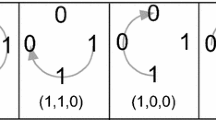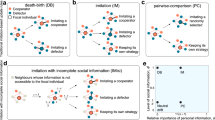Abstract
The idea that a group of cooperating agents can solve problems more efficiently than when those agents work independently is hardly controversial, despite our obliviousness of the conditions that make cooperation a successful problem solving strategy. Here we investigate the performance of a group of agents in locating the global maxima of NK fitness landscapes with varying degrees of ruggedness. Cooperation is taken into account through imitative learning and the broadcasting of messages informing on the fitness of each agent. We find a trade-off between the group size and the frequency of imitation: for rugged landscapes, too much imitation or too large a group yield a performance poorer than that of independent agents. By decreasing the diversity of the group, imitative learning may lead to duplication of work and hence to a decrease of its effective size. However, when the parameters are set to optimal values the cooperative group substantially outperforms the independent agents.
Similar content being viewed by others
References
E. Wilson, Sociobiology (Harvard University Press, Cambridge, 1975)
A. Whiten, D. Erdal, Phil. Trans. R. Soc. B 367, 2119 (2012)
H. Bloom, Global Brain: The Evolution of Mass Mind from the Big Bang to the 21st Century (Wiley, New York, 2001)
C.L. Nehaniv, K. Dautenhah, in Imitation and Social Learning in Robots, Humans and Animals (Cambridge University Press, Cambridge, 2007), pp. 1–18
J. Kennedy, Adapt. Behav. 7, 269 (1999)
E. Bonabeau, M. Dorigo, G. Theraulaz, Swarm Intelligence: From Natural to Artificial Systems (Oxford University Press, Oxford, 1999)
J. Kennedy, J. Conflict Res. 42, 56 (1998)
J.F. Fontanari, Phys. Rev. E 82, 056118 (2010)
L. Hong, S.E. Page, J. Econ. Theory 97, 123 (2001)
S.E. Page, The Difference: How the Power of Diversity Creates Better Groups, Firms, Schools, and Societies (Princeton University Press, Princeton, 2007)
B.A. Huberman, Physica D 42, 38 (1990)
S.H. Clearwater, B.A. Huberman, T. Hogg, Science 254, 1181 (1991)
J.F. Fontanari, PLoS One 9, e110517 (2014)
R. Axelrod, The Evolution of Cooperation (Basic Books, New York, 1984)
S. Kauffman, S. Levin, J. Theor. Biol. 128, 11 (1987)
S. Kauffman, E. Weinberger, J. Theor. Biol. 141, 211 (1989)
D. Solow, A. Burnetas, M. Tsai, N.S. Greenspan, Complex Systems 12, 423 (2000)
M.R. Garey, D.S. Johnson, Computers and Intractability: A Guide to the Theory of NP-Completeness (Freeman, San Francisco, 1979)
B. Derrida, Phys. Rev. B 24, 2613 (1981)
D.B. Saakian, J.F. Fontanari, Phys. Rev. E 80, 041903 (2009)
Y. Shibanai, S. Yasuno, I. Ishiguro, J. Conflict Res. 45, 80 (2001)
J.C. González-Avella, M.G. Cosenza, M. Eguíluz, M. San Miguel, New J. Phys. 12, 013010 (2010)
L.R. Peres, J.F. Fontanari, Europhys. Lett. 96, 38004 (2011)
L.R. Peres, J.F. Fontanari, Phys. Rev. E 86, 031131 (2012)
R. Axelrod, J. Conflict Res. 41, 203 (1997)
M. Perc, A. Szolnoki, BioSystems 99, 109 (2010)
Z. Wang, L. Wang, M. Perc, Phys. Rev. E 89, 052813 (2014)
W.H. Press, S.A. Teukolsky, W.T. Vetterling, B.P. Flannery, in Numerical Recipes in Fortran: The Art of Scientific Computing (Cambridge University Press, Cambridge, 1992), pp. 480–486
W. Feller, in An Introduction to Probability Theory and Its Applications, 3rd edn. (Wiley, New York, 1968), Vol. 1, p. 220
R.I.M. Dunbar, J. Human Evol. 22, 469 (1992)
T. Wey, D.T. Blumstein, W. Shen, F. Jordán, Anim. Behav. 75, 333 (2008)
S. Watts, The People’s Tycoon: Henry Ford and the American Century (Vintage, New York, 2006)
Author information
Authors and Affiliations
Corresponding author
Rights and permissions
About this article
Cite this article
Fontanari, J.F. Exploring NK fitness landscapes using imitative learning. Eur. Phys. J. B 88, 251 (2015). https://doi.org/10.1140/epjb/e2015-60608-1
Received:
Revised:
Published:
DOI: https://doi.org/10.1140/epjb/e2015-60608-1




